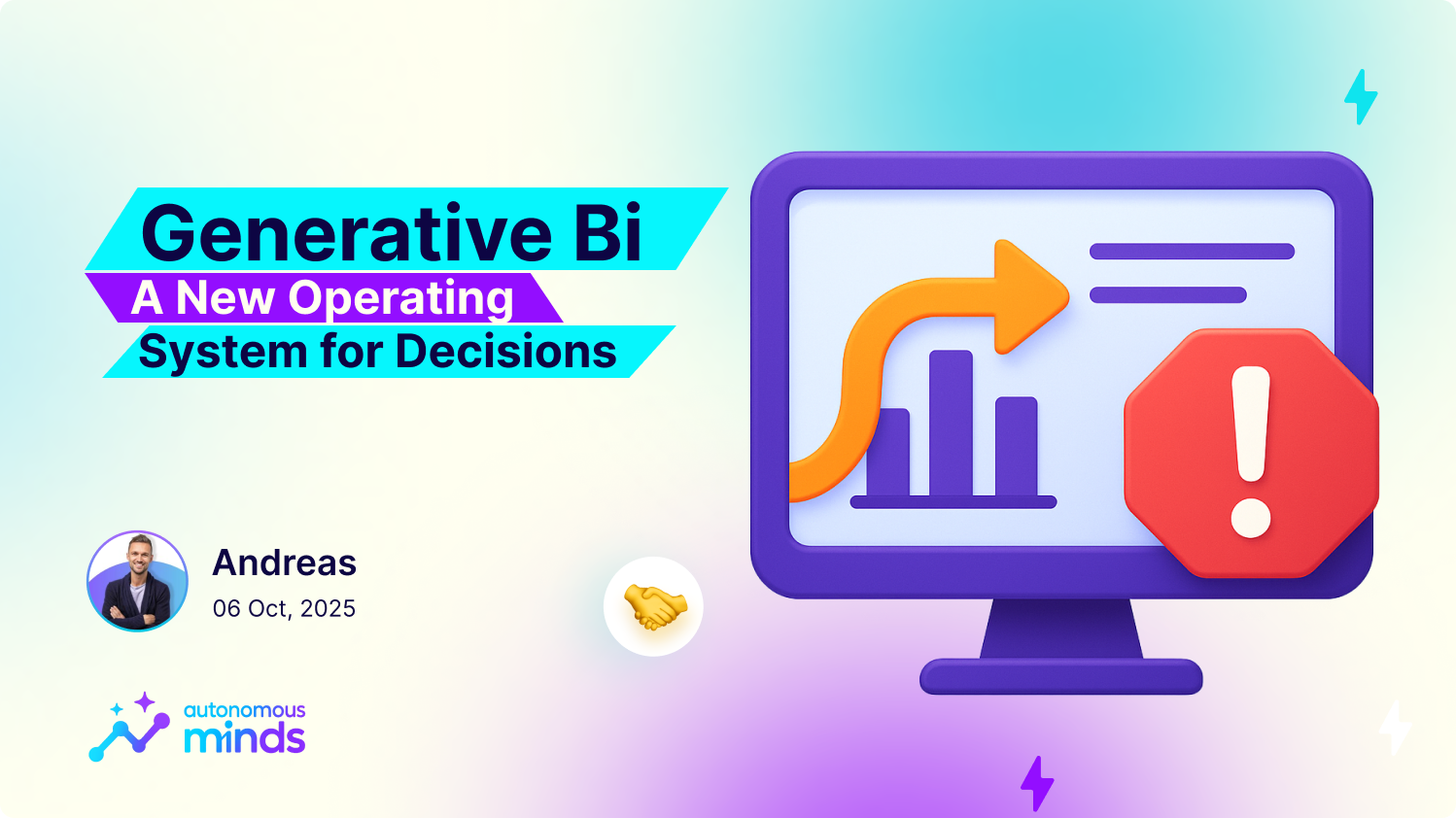The problem with BI as a silo
Most BI organizations were designed to publish dashboards, not to run the business. The consequences are familiar:
- High cost, low velocity: Companies pay roughly $650–$1,200 per FTE per year for BI software and headcount, before infra, yet still wait a week to 10 days for an analysis or dashboard refresh.
- Static answers: By the time a report arrives, the window to act has closed. The business ends up in meetings discussing the data, rather than with actions triggered.
- Spreadsheet sprawl: Analysts reinvent the same reports across tools and data sources; insight rarely survives the copy-paste into a slide.
The result is a gap between data and decisions: a lot of what, very little why, and almost no done.
The shift: From reporting to What -> Why -> Done
Generative BI changes the job to be done. Instead of issuing tickets to a BI team, operators ask questions in plain English and get:
- What: “Explain yesterday’s margin drop in EMEA; share a summary with the regional lead.”
- Why: A causal narrative, which drivers moved, by how much, with evidence, not just charts. Pulled together and logically connected across multiple data sources.
- Done: Triggered follow-through, e.g. Slack summary, CRM task, a partner-ready PDF, with approvals and audit.
Said differently: GenBI fuses analytics + operations. Your “BI tool” behaves less like a static dashboard and more like an operating system for decisions, a lightweight version of the “AI COO” you may derive from the above.
(And yes, the above can run independently and autonomously, if you allow).
Why this folds BI into the business (instead of standing apart)
- Democratized access: Anyone can request a fresh analysis or dashboard in minutes using natural language, across any data source (warehouse, DBs, spreadsheets, SaaS).
- Causal context: Instead of “revenue down 7%”, you get “device mix shifted to mobile web; UK promo ended; two large orders slipped”, with linked evidence.
- Operational follow-through: Insights don’t die in dashboards; the system can update CRM, post to Slack, or send a report, all under RBAC, approvals, and audit.
When the same surface both explains and executes, BI stops being a reporting service and becomes how the org decides and acts.
What this looks like in practice (three quick scenarios)
- RevOps: “Pipeline is trending down, why?” GenBI returns the top drivers (segment/rep/region slippage; reduced win rate after pricing change), then creates recovery tasks for owners and a Slack summary for leadership.
- Customer Success: “Churn risk for Q4?” The system identifies cohorts with usage dips or ticket surges, drafts an outreach plan, and opens follow-ups in CRM, no spreadsheet merging required.
- iGaming integrity: “GGR spike in UK, explain and brief Brand X.” GenBI highlights deposit-velocity changes and odd hours, checks live campaigns, support tickets, and Slack chatter for context, then sends a PDF and creates a CRM task, in minutes, 24/7.
Across all three, the north-star metrics aren’t “dashboards shipped”. They’re P95 time-to-insight and P95 time-to-action: how quickly 95% of requests resolve into explanations and steps taken.
What has to be true (guardrails and habits)
To avoid replacing slow BI with risky automation, bake in simple guardrails:
- Access & scope: role-based permissions and tenant isolation.
- Allow-lists: only certain fields and destinations are writable.
- Approvals: required when a playbook touches many users or sensitive data.
- Receipts: every action returns an audit trail and supports undo.
- Short retention: caches/logs/artifacts expire quickly.
These are boring by design, and the reason operators will trust the system.
The bottom line
BI won’t “disappear”; it will stop being a separate function. In a GenBI world, analysis and action live in the same motion. Teams ask in plain English, get the why, and ship the next step, with governance. That’s how you convert spend and dashboards into decisions that move the business, in minutes, not days.
An operating system instead of static tools your users hate.

